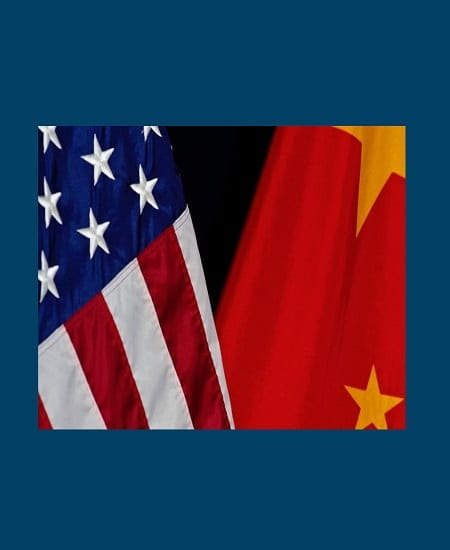2/21/19: A Viewpoint on the National Defense Strategy and Competition with China

A Viewpoint on the National Defense Strategy and Competition with China
By Yehna Bendul, Research Staff Assistant, Sigur Center for Asian Studies
The National Bureau for Asian Research’s (NBR) latest publication, Strategic Asia 2019: China’s Expanding Ambitions, defines China’s strategic goals and analyzes its attempts to reshape the international order. On February 7th, the Sigur Center and NBR held a series of discussions to mark the release of the publication. Randall G. Schriver, the Assistant Secretary of Defense for Asian and Pacific Security Affairs and the keynote speaker for the event, discussed how the Department of Defense characterizes the future with China as well as how the United States plans to respond.
Assistant Secretary Schriver began his remarks by acknowledging that past defense strategies have been unclear in their hierarchies of priorities but emphasized that the 2018 strategy sees interstate competition as its primary focus. Within this focus on interstate competition, China is seen as the most prominent competitor to the United States. Assistant Secretary Schriver cited China’s simultaneous exploiting and undermining of international norms and the liberal rules-based international order as the primary reason for competition. This was followed by a concern for China’s authoritarian principles and violations of other countries’ sovereignties with the intent to spread such principles. Lastly, Assistant Secretary Schriver stressed that the fact that China sees itself in competition with the United States is reason enough to reciprocate.
Assistant Secretary Schriver discussed five ways in which the United States plans to adapt and respond to China’s challenge. First is that the U.S. armed forces need to understand that it can be contested and that this conflict will not be “an easy win,” as China is rapidly modernizing its military. Second, the United States can no longer look at competition through a binary lens. That is to say, the mindset of expecting clear wins and losses on a day-to-day basis is unproductive. Not only does China engage in “salami-slicing tactics” – or a piecemeal style strategy that seeks to gradually and selectively change the status quo – but China also keeps its activity in the “gray zone.” In other words, China acts in coercive and aggressive ways but deliberately limits its activities to remain just below the threshold of what would trigger military retaliation. Thus, Assistant Secretary Shriver argues that competition with China will require the United States to remain vigilant even among seemingly innocent action.
The third, and one of the most crucial, components of the U.S. defense strategy in the Asia-Pacific is strengthening relationships with allies and partners in the region. China has both a geographical and a first-mover advantage which limit the scope of unilateral U.S. action. Thus, the United States must rely on good relations with countries in the region to project power and counter China. Fourth, Assistant Secretary Schriver stressed the importance of informing allies and others of the reality of the Belt Road Initiative and other ostensibly economic ventures like 5g infrastructure investment. While more countries are becoming aware of the military and political objectives associated with these projects, Assistant Secretary Schriver acknowledged that simply shining light on the situation is not enough. Competition on this front will require the United States to ensure that it can provide alternative options for countries to turn to, thus requiring investment in our own infrastructure projects and 5g technology. Lastly, the United States needs to recognize that this competition will extend beyond the current generation, and as such must conduct long-term planning accordingly. Assistant Secretary Schriver concluded his talk by stating that this strategy is inclusive and positive in that its priority is protecting important and enduring principles. To him, the trajectory of the conflict can be peaceful, but the onus is on China to stop violating these principles.
This last note echoes a point that NBR panelist and Senior Policy Analyst at USIP, Dr. Patricia Kim, made during her remarks which was that U.S. strategy in the Asia-Pacific region should not just be a policy of containment of China but rather something broader and focused on more positive goals. She added that states in the region have no desire to be forced to choose between the United States and China and that it is U.S. support for democracy, free trade, and other such principles that fundamentally underpin its soft power in the region. While it is essential to signal to China that destabilizing actions will not be tolerated, a necessary part of this kind of positive strategy is reassuring China that the United States does not seek to keep China down. Dr. Kim asserted that an aggravated and isolated China is just as destabilizing, if not more, than what it is now.
A serious problem with this strategy, however, is that the United States’ own track record of following international norms and laws is not an exemplary one. This question of how the United States can claim to be acting out of a desire for global justice and according to norms and laws when it has historically failed to do so was brought up in the Q&A session. Assistant Secretary Schriver’s response was that the question cherry-picked examples and that in every case, there were justified trade-offs. However, there is a plethora of examples to look to where the United States either explicitly violated laws (such as the Iran-Contra Affair) or took morally and legally questionable actions (such as the “Highway of Death”). Even now, the United States has yet to sign the United Nations Convention on the Law of the Sea (UNCLOS) but holds China to those exact standards in the South China Sea. Consequently, any attempts to try to convince China and others in the region that United States intentions are based more on principle than geopolitical interests seem somewhat futile or questionable at best.
Moreover, there are major concerns about the U.S. Department of Defense’s ability to actually implement its strategy. Analysis from the Center for Strategic and International Studies not only stress a history of dysfunctionality but a number of structural and budgetary concerns that would make effectively implementing a long-term strategy in a cohesive manner improbable. The departure of Secretary of Defense Jim Mattis only adds to the troubles and challenge of China. While the United States is not alone in facing internal challenges, it is clear that China is quickly becoming, if not already, a genuine competitor. Whatever the outcome is between these two great powers, there will be significant and complex impacts on the rest of the world.
 Yehna Bendul is a sophomore in the Elliott School studying Philosophy and International Affairs. Her concentration is in international politics with a focus on Latin America and East Asia.
Yehna Bendul is a sophomore in the Elliott School studying Philosophy and International Affairs. Her concentration is in international politics with a focus on Latin America and East Asia.

